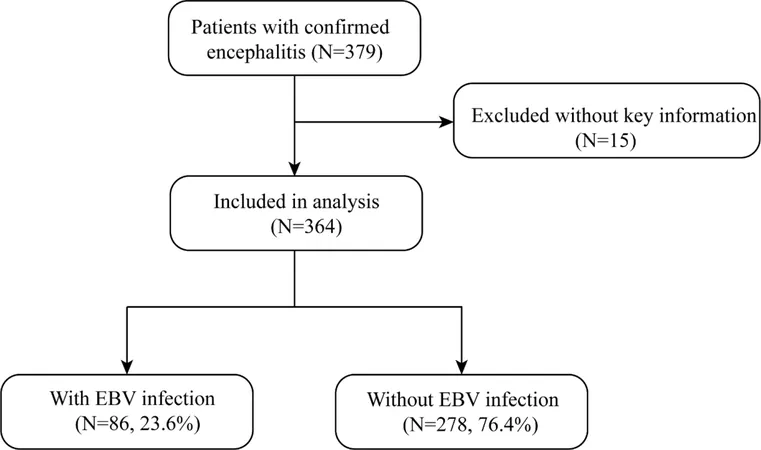
Unveiling the Deadly Link: Epstein-Barr Virus and Encephalitis in Patients
2025-05-13
Author: Li
A Hidden Culprit: Epstein-Barr Virus in Encephalitis
The Epstein-Barr virus (EBV), commonly known as a leading cause of mononucleosis, is now being recognized as a significant player in cases of encephalitis—a severe brain infection. Yet, our understanding of EBV-associated encephalitis remains minimal. A recent study shines a light on its clinical features and potential risk factors among a large cohort of Chinese patients.
Study Overview: Analyzing 364 Cases of Encephalitis
Conducted between June 2020 and April 2021, this retrospective study examined 364 patients diagnosed with encephalitis at a medical center. Among these, a staggering 86 cases (23.6%) tested positive for EBV in their cerebrospinal fluid (CSF), with 39 of them diagnosed specifically with EBV-associated encephalitis.
Distinct Clinical Characteristics of EBV Encephalitis
What sets EBV-associated encephalitis apart? The findings reveal that patients display significantly higher protein levels and lower glucose levels in their CSF compared to those infected with other herpes viruses. In particular, the incidence of meningeal involvement on MRI scans was notably higher in EBV patients—30.6% versus just 6.5% for other herpes-related encephalitis.
Risk Factors: Who Is Most Vulnerable?
The study identified several independent risk factors for CNS EBV infection: age, HIV infection, non-tumor immunosuppression, and active peripheral blood EBV infection. This indicates that certain demographics may be more prone to severe EBV complications.
A Global Health Concern: The Stakes Are High
Encephalitis is not only rare (affecting roughly 1.7 to 7.4 people per 100,000 annually) but can lead to devastating outcomes—up to 10% mortality in acute cases, with many survivors facing long-term neurological challenges. With EBV increasingly linked to severe outcomes, understanding and identifying this virus's role in brain infections is critical.
Implications for Future Research and Treatment
These findings propel EBV-associated encephalitis into the spotlight, warranting further investigation. The study suggests that lymphoid systems in the brain might allow EBV to invade the CNS, where immunosuppression plays a pivotal role. This positions EBV as an opportunistic infection that capitalizes on weakened immune defenses.
Conclusion: Time for Vigilance and Awareness
As EBV continues to unveil its insidious nature, healthcare professionals must remain vigilant. The compelling evidence linking EBV to encephalitis could shape future diagnostic and treatment strategies, paving the way for better management of this life-threatening condition. Keeping patients informed and healthy is paramount in the battle against this viral adversary.




 Brasil (PT)
Brasil (PT)
 Canada (EN)
Canada (EN)
 Chile (ES)
Chile (ES)
 Česko (CS)
Česko (CS)
 대한민국 (KO)
대한민국 (KO)
 España (ES)
España (ES)
 France (FR)
France (FR)
 Hong Kong (EN)
Hong Kong (EN)
 Italia (IT)
Italia (IT)
 日本 (JA)
日本 (JA)
 Magyarország (HU)
Magyarország (HU)
 Norge (NO)
Norge (NO)
 Polska (PL)
Polska (PL)
 Schweiz (DE)
Schweiz (DE)
 Singapore (EN)
Singapore (EN)
 Sverige (SV)
Sverige (SV)
 Suomi (FI)
Suomi (FI)
 Türkiye (TR)
Türkiye (TR)
 الإمارات العربية المتحدة (AR)
الإمارات العربية المتحدة (AR)